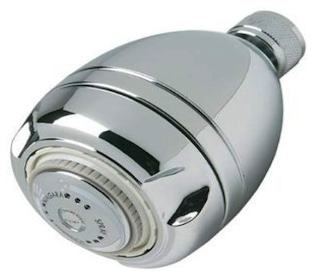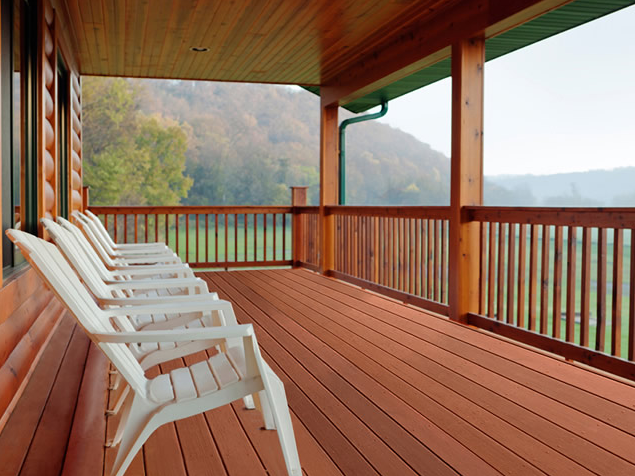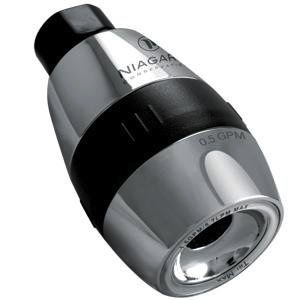Niagara Tri Max Low Flow Showerhead Review
Robert Andrews, Staff Writer
In our neverending search for the most efficient home products available, we turn this time to the shower head. While showering uses much less water (and time) than taking a bath, most conventional showerheads today still use way more water than they need. Water saving, low flow showerheads are constantly improving, providing a satisfying shower experience without using a lot of water. One of the most efficient, and affordable, of these low flow showerheads is the Niagara Tri Max.
Many low flow showerhead manufacturers make bold claims that their product sips water while giving users the strong water pressure they want. My experience with many of these is that often the showerhead just doesn't live up to its hype. There's only one way to determine whether or not the Tri Max works as well as Niagara says it does: Buy one, and try it out.
Saving Water at Home: A Primer
There are many, many ways to use less water around the house. Fortunately, many of them are inexpensive to implement, and can result in drastic usage reductions and associated financial costs. For a basic overview of home water conservation, see our article HERE.
Niagara Tri Max: An Unbiased Test
I purchased a Tri Max showerhead from an online retailer, paying the same price as any other consumer. The goal here is to determine how well it works, and if it's a worthy option for homeowners looking to use less water.
Tri Max: Three Convenient Settings
To be considered a "low flow" showerhead, it must use 2.5 gallons of water per minute or less. While this is the standard, it is a minimum. There are many products on the market today that use much less. Our goal at Green Home Product Source is to find the showerhead that uses the least amount of water while still providing a spray that satisfies. Trust me, many low flow showerheads don't do this very well, with a spray that is more like a heavy drizzle. While a showerhead with a poor-quality spray will make you want to get out of the shower more quickly is one way to use less water, it's not what we're looking for here.
The Niagara Tri Max provides a spray at three different levels: 1.5 gallons per minute (gpm) at the highest level, a 1.0 gpm middle setting, and an ultra-low 0.5 gpm flow. Niagara recommends the lowest rate for soaping up, and the higher two settings for rinsing.
Many showerheads on the market advertise low flow rates of 1.0 or 1.5 gpm, but the Tri Max is one of the only models I've come across that feature 3 settings. I prefer shaving in the shower, which is admittedly a water waster. If the Tri Max can allow me to turn the water flow down to .5 gpm, I can save a great deal of water. But how well does this thing work?
Tri Max Performance
After receiving my Niagara Tri Max, I was anxious to get it installed and working. Installation was simple: just unscrew the old showerhead, and screw on the Tri Max. (I recommend using a teflon tape to prevent leaking.)
The first thing I noticed when turning it on (at the 1.5 gpm setting) was the strong flow. Unlike some low flow showerheads that inject air into the water stream to reduce gpm (resulting in a "windy", misty spray) the Tri Max spray was fairly strong, and not unlike a much higher gpm head. This is a perfect setting for rinsing off. So far, so good.
Next, I turned the dial to the 1.0 gpm setting. Obviously, the stream weakened a bit, but not as much as I was expecting. The flow rate still seemed fairly strong, and was still adequate enough for good rinsing. After a year of usage, the 1.0 gpm setting is the one I use the most, for maximum water savings. (My teenage kids prefer the 1.5 gpm setting). Flow rates this low are uncommon; flow rates this low with a satisfactory pressure level are rarer still.
Finally, it was time for the lowest setting, 0.5 gpm. Again, I was surprised to find a pressure flow that still amanged to keep me wet. Many low flow showerheads have a 'shut-off' valve that turns the water down to a mere trickle, but it's usually so low that I don't think many people would honestly use it much.
The 0.5 gpm rate is perfect for my shaving routine. It's enough to keep the water hitting me, and keeping me from getting cold on winter mornings.
In all, I find the Niagara Tri Max to be a very nice water saving showerhead. It's important for all of us to do our part to conserve water; it's my opinion that most Americans won't do it if it significantly impacts their personal comfort levels. I don't like it, but I think it's true.
Niagara Tri Max: Affordable Water Savings
The Tri Max low flow showerhead works, and in my opinion works pretty well. Any low flow showerhead will reduce water usage and water bills, but some will do it quicker than others. Many showerheads in the 'ultra-low' category of 1 or 1.5 gpm can get expensive. I've seen some that run upwards of $75. While they are well-built (all-brass construction) and will eventually pay for themselves with reduced energy and water costs, more affordable is usually a good thing.
The Tri Max is incredibly affordable: I paid around $15 for mine, and have seen then as low as $9. At prices this low, the payoff turnaround will only take 5 or 6 months. After that, you're saving money and water every single day! The Niagara Tri Max is made primarily of high-impact plastic, unsurprising with its lower price. Those looking for a more refined look of metal or brass should look elsewhere. Being plastic may shorten the overall life span of the Tri Max, but after more than a year of daily use, we have not experienced any negative issues.
My Conclusion: At this price, with its more than satisfactory pressure levels and super water-efficiency, the Niagara Tri Max is a perfect place to start with using much less water at home.
comments powered by Disqus








































































































































